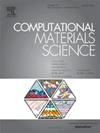Atomistic study of capturing mechanism for defects of anti-reflective coating by polymer membranes
IF 3.3
3区 材料科学
Q2 MATERIALS SCIENCE, MULTIDISCIPLINARY
引用次数: 0
Abstract
The bottom anti-reflective coating (BARC) layer is an effective way of suppressing the multiple inner reflections of light in photoresist materials for modern lithography. Although the siloxane-based polymers work sufficiently well as BARC, their performance can be compromised by even extremely small amount of defect components represented by cage-type Silsesquioxane molecules. In this paper, we perform atomistic modeling to understand what polymer materials can be efficiently used as filtering membranes to filter the defects from the BARC solution. From the analysis of the interactions between the defects and filtering membranes, we found that the polymer membranes with aromatic rings, such as Kapton, can more efficiently capture the BARC defects due to strong π–π interactions.

聚合物膜对减反射涂层缺陷捕获机理的原子性研究
底层抗反射涂层(BARC)层是现代光刻中抑制光致抗蚀剂材料多次内反射的有效方法。尽管基于硅氧烷的聚合物与BARC一样工作得很好,但它们的性能可能会受到以笼型硅氧烷分子为代表的极少量缺陷成分的影响。在本文中,我们执行原子建模来了解哪些聚合物材料可以有效地用作过滤膜来过滤BARC溶液中的缺陷。从缺陷与过滤膜的相互作用分析中,我们发现带有芳香环的聚合物膜,如Kapton,由于强π -π相互作用,可以更有效地捕获BARC缺陷。
本文章由计算机程序翻译,如有差异,请以英文原文为准。
求助全文
约1分钟内获得全文
求助全文
来源期刊

Computational Materials Science
工程技术-材料科学:综合
CiteScore
6.50
自引率
6.10%
发文量
665
审稿时长
26 days
期刊介绍:
The goal of Computational Materials Science is to report on results that provide new or unique insights into, or significantly expand our understanding of, the properties of materials or phenomena associated with their design, synthesis, processing, characterization, and utilization. To be relevant to the journal, the results should be applied or applicable to specific material systems that are discussed within the submission.
 求助内容:
求助内容: 应助结果提醒方式:
应助结果提醒方式:


